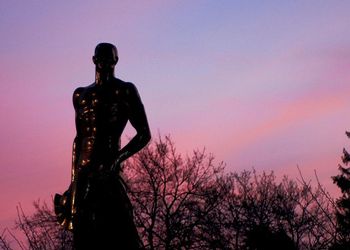Feature: How an MSU Professor Helped Popularize Spring Break

Fifty years ago, an MSU professor helped spur the cultural phenomenon we know today as Spring Break ... all because he was fascinated by an MSU student who drove a red convertible.
When 1961 arrived it had already been a long winter for MSU students. Madras, Bermuda shorts and the limbo were still a dream. Until then MSU students were plugging jukeboxes with nickels to listen to Connie Francis sing her dreamy, romantic ballad "Where the Boys Are," which went on to chart No. 1 in 15 countries.
Across Grand River, on date night, coeds held hands while waiting for tickets at the Campus Theatre to see the new movie Where the Boys Are. A few standing in line had already read the New York Times best-selling book, written by an MSU professor who based his novel on an actual spring break experience in Fort Lauderdale with his MSU students.
The couples made casual talk about how the opening scenes to the movie showed snow whipping around Berkey Hall and that a character in the movie, TV Thompson, was from Michigan State.
Spring break was right around the corner and many students were already making plans to pack their Coppertone, pile six into a car and drive more than 30 hours non-stop to Florida for a week of fun in the sun. Th e book, the movie and the song Where the Boys Are were about to transform American culture. They would catapult spring break from a fling for swimmers from northern schools to a cultural rite of passage for all college students.
The number of spring breakers in Fort Lauderdale grew from 15,000 to some 370,000 over the next two decades. Today, the total number of spring breakers-including those in alternative, volunteer programs-is estimated to be well over one million.
The impact of the $1.4 million movie, with stars like George Hamilton, Yvette Mimieux, Paula Prentiss, Jim Hutton and singing idol Connie Francis, was huge and immediate-earning MGM its biggest box office in history for a budget movie.
As spring breakers hit the beaches and slopes in exotic locales today, few if any have any clue that they form part of a cultural phenomenon that was fueled a half century ago by the active imagination of an MSU professor.
Glendon Swarthout, PhD '55, was an associate professor of English at MSU for eight years. He was teaching an honors class in 1958 when he overheard one of his students talking about spring break. In particular, recalls his spouse Kathryn Swarthout, MA '56, "Glendon had heard a young man from Jackson with a red sports car talking about spring break. He is the one responsible for the novel."
When Swarthout asked his students for more specifics, he was invited to join them in Fort Lauderdale and see for himself. It was no surprise that the young English professor took up the off er, says David Anderson, MSU English professor emeritus and a colleague and friend of Swarthout's."Almost from the beginning Glendon believed he was a reincarnation of Ernest Hemingway, right down to his moustache and his demeanor," Anderson recalls.
By 1960, Swarthout had already lived an adventurous life, saw combat action in Italy during World War II, roamed the globe and published two novels. Willow Run (1943) was based on his and Kathryn's experience building B-24 bombers in Ypsilanti, prior to enlisting for war service. They Came To Cordura (1958) was made into a successful movie starring Gary Cooper and Rita Hayworth. His short story "A Horse for Mrs. Custer" had also been made into a movie, Seventh Calvary (1956), starring Randolph Scott and Barbara Hale. Presaging Boys, he published a short story for Esquire in January 1959 that his son, Miles Swarthout, describes as a "gimleteyed examination of these self-centered, overgrown adolescents." A Swarthout novella and 13 short stories appear in Eastern and Westerns (MSU Press, 2001), a posthumous literary collection compiled by his son Miles Swarthout.
Glendon was an avid researcher, according to Kathryn, who now lives in Tucson, Arizona. She spent three months with him in Mexico doing research for Cordura, a tale about General Pershing's search for the legendary Pancho Villa. According to Anderson, the publishing of Cordura was "quite a celebrated occasion on campus."
"It was going to be reviewed in Time magazine," recalls Anderson."Glendon dreaded it because he was afraid they would tear him apart. But in fact it did get a good review-and they ran his picture, complete with his moustache."
Interestingly, it was Time magazine that helped inspire the title for his project about spring break, recalls Miles. In a 1959 article, Time asked a coed why she went to Fort Lauderdale. Her reply was, "That's where the boys are."
In a 1985 interview with Larry King, Swarthout explained how his book came to be: "(My students) were fun, they were kicks, and they kept talking about spring vacation in Fort Lauderdale. It occurred to me I'd like to see what they did. So I asked . . . If I Came down if they'd show me around. They told me where to stay, they met me at the airport and I had a week with them.
It occurred to me as the week progressed that this would make a very fine novel. I could at the same time write a kind of profile of that particular generation-their aspirations, their hopes, their fears and so on." Just emerging from the somnolent 1950s, Swarthout's novel would create quite a stir with its frank portrayal of sexuality and its depiction of a social consciousness that would foreshadow the rise of the protest movement in the late 1960s. But the movie, less salacious and oft en corny, would create even a bigger stir and fuel the migratory numbers that characterize the modern spring break. Joseph Pasternak, who directed the movie, admitted to the Miami Herald (June 1960), "When the book came out we thought it was a little too risqué, (so) it was cleaned up to suit the family trade." Doug Noverr, professor of English, says the novel was "funny, witty, inventive, and specifically about Michigan State students, whereas the film is a commercial product."
Both the movie and the book tell the relatively simple story of a group of Midwestern students (Tuggle, Merritt, Ryder, TV Thompson, Melanie and Angie) in search of fun in the sun. All the protagonists in the book were specifically MSU students, but in the movie, only TV Thompson (Jim Hutton) was so designated.
A good chunk of the book never made it into the movie. Among the cuts were scenes dealing with such issues as unwanted pregnancies, responsibility, serious learning in college, and running guns to help Fidel Castro in Cuba. A scene that we would recognize Today as date rape, however, did make it to the big screen.
"The book did a remarkable job of capturing the social psychology of an entire generation," says Noverr. "It was a generational portrait, as Glendon once said.
In the book, Merritt and her friends had an uneasiness of the world about them: the Cold War, ICBM missiles, nuclear bombs, the draft and sexual experimentation- all things that projected later into the 1960s. They were very much in the background of the novel but we don't see any of them carried into the movie." Novrr says the novel, set in 1958, shows glimpses of the idealism that came out in the late 1960s.
"One of the great comic scenes Was when some students tried to recruit others to join the rebels in the mountains of Cuba," he says. "It was a complete failure, but there you see that idealism of wanting to change things." Nover says yet another theme in the book was the very limited options women had available to them. "You see Merritt frustrated with the choices," he says.
"She's a J.D. Salinger character- it's the Holden Caulfield experience at a different level." The movie may have missed Many of these key themes, but it nonetheless had a major impact on mass culture. Prior to 1960 the beach town of Fort Lauderdale hosted an estimated 15,000 students during spring break, according to city historians. The year after the book and movie came out more than 50,000 students would descend on this sleepy town. At its height in 1985, some 370,000 students would make it there. Soon after, it would take a backseat to other locales popularized by the MTV channel.
Th e movie also helped launch the careers of a number of stars and starlets and unleashed a series of beach blanket and surf movies.
Paula Prentiss, George Hamilton, Dolors Harts, Yvette MimieuxConnie Francis and Jim Hutton (TV Thompson) would all make their mark in this comedic farce. In both book and movie, Thompson was depicted as a con-man and cad. Swarthout compares him to the eccentric filmmaker Michael Todd.
The book featured such obscure cultural references as "babyroo" or "bang your pipes," words a modern reader might have trouble comprehending. Although the book is out of print, it is available In e-book format via Amazon.com and other vendors.
Today far more people probably remember the movie more than the book, says MSU English Professor Gary Hoppenstand, editor of the Journal of Popular Culture and a fan of the movie.
"Movies help create myths and in fact reality is obscured or redefined by popular culture," he says.
A case in point: generations of MSU students have been led to believe that the opening snow scenes of the movie were shot at Berkey Hall. But such was not the case. "I'm so sorry to tell you so, but it was shot at a back lot in L.A.," insists Paula Prentiss, who was in Lansing in 2010 performing at a local theater. She says most of the footage, except for exterior shots, was shot on a sound stage in Culver City. Yet it was not uncommon for MSU students then to point themselves out in the movie.
The movie made some authentic Fort Lauderdale spots, like the Elbo Room (not Elbow Room, as erroneously reported by some media), into iconic places. The two-story Elbo Room bar which appears in both the book and the movie has acquired legendary status and remains open today.
Stan Eichelbaum, '67, a native Detroiter who now lives in Fort Lauderdale, recalls his first visit in 1969 when he was a student.
"Everyone from the Coral Gables And Grandmother's was going," he recalls. "It was as if the East Lansing bars were moved to Fort Lauderdale." Eichelbaum says that today, the Elbo Room abuts a condo development and several four- and five-star hotels and restaurants- smack dab in the area where police used to gather to quell riots.
"Fort Lauderdale is no longer a sleepy beach town," he notes. "It is on the edge of being a world class City and deciding where it wants to be long range." He says the beach is still packed, but the revelers are just as likely to be older tourists from Brazil, Venezuela or Great Britain.
It seems fitting that Glendon Swarthout, who helped kick-start such enormous change, boasts a background that is more adventuresome- or Hemingwayesque- than that of a typical college professor. As an undergraduate at the University of Michigan, he might have been viewed as somewhat of a nerd, having played accordion in a dance band. Aft er he and Kathryn married in 1940, however, they embarked on an extended cruise to South America, paying for the voyage by writing syndicated travel stories for 22 newspapers. When Pearl Harbor was bombed, they found themselves stranded in Barbados. Ever resourceful, they spent the next five months catching a series of freighters to reach New York City while avoiding German submarines. One of the freighters they were on was later sunk by a U-boat.
Returning to Michigan, both Swarthouts worked at the Willow Run plant in Ypsilanti making B-24 bombers. Glendon, then skinny as a beanpole, was initially turned down for military service but later gained enough weight to be accepted. He ended up serving in Audie Murphy's 3rd Sinfantry Division in Italy and was part of the breakout at Anzio. After the war he returned to the University of Michigan and then taught at the University of Maryland before moving to East Lansing where he and Kathryn would obtain advanced degrees while he worked as a member of the faculty.
Glendon had a penchant for writing books that could become movies. In fact, eight of his 16 books and short stories were sold to the movies, including They came to Cordura, Seventh Cavalry and Bless the Beasts and the Children. Many film buff s will remember The Shootist (1976), John Wayne's last movie, which is considered one of the best adaptations of Swarthout's writings.
Like Paula Prentiss, Connie Francis and several others, Swarthout is still remembered mainly for Where the Boys Are-despite having enjoyed many other successes. Swarthout also became an acclaimed writer of westerns, winning the Spur Award for Best Western Novel twice-for The Shootist in 1975 And The Homesman in 1988. In 1991, he received the Western Writers' Owen Wister Award for Lifetime Achievement at the National Cowboy & Western Heritage Museum (previously known as National Cowboy Hall of Fame). He and Kathryn would also co-write six western adventure novels for juveniles.
"So much of it (Swarthout's western literature) is brilliant," says Gary Hoppenstand. "It's hard to nail him down. For example, Cordura was seen as a very, very dark novel, but he later wrote The Tin Lizzie Troop (1972), about the same expedition to Mexico, but it's a comedy. This illustrates his Versatility and also-I hate to use this word, but I'll use this word- his genius at writing."
Hoppenstand adds that Boys was "a literary masterpiece of its era" that "helped to create a mythological lexicon that is still standing-a genre that continues today as the beach film-and this is something not many writers have ever achieved."
Although the transformational impact of Boys cannot be underestimated today, not all initial reviews were favorable. Some reviewers condemned it as "risqué," "dismal" and "preoccupied With sex." The negative reviews, though, were balanced by many supportive letters that poured into the publisher and MGM Studios.
Among the positive letter writers were three former MSU coeds who had taken classes from Swarthout.
Joan Byrne, '58, said she recognized instantly "the school, the dorms . . . And the 10 o'clock crush tubbings and above all Dr. Glendon Swarthout, who will never be dull." As a former student in his class, she wrote, "I don't agree on every count, I am for the fl at earth." Another student of his, Patricia Koehler Meyer, recalls coming back late from spring break offering up car trouble as an excuse.
"Upon conferring with you I agreed to write a 5,000 word essay on my experience in Florida as you were in the process of writing this book," she wrote in a three-page typed letter. "I might add that had I known the context of the book at the time I'm sure I could have added much flavor to my paper." Meyer went on to describe his classes as "the pause that refreshed in the desert of poker-face nosense- of-humor professors." Another of his students, Bonnie Stambaugh, writing as Mrs. David Brown, told Swarth out, "If I was asked what teacher I liked the best and learned the most from, without a doubt I would name you." There were, of course, the usual number of letters accusing Boys of fostering communism.
One writer wished to "strongly protest your novel as dangerous to American youth because it is hilariously funny, inexcusably profane and positively immoral." The writer added that "the fact that it is beautifully written and very funny cannot excuse its low moral tone." One student from a college in New York wrote, "I found your book to be the most entertaining piece of literature I have ever had the pleasure to come across."
Many of the responses came from women, notes Miles, because the novel was written from the female point of view-which was unusual at the time. "Many coeds related to it," he explains.
"(Glendon) would get impassioned letters from women who went through the same thing."
When the movie premiered on December 28, 1960, all the major trade papers and daily newspapers were quick to publicize it. MGM had launched an all-out publicity Campaign, sending cast members to every major media market. As Prentiss recalls, "We were on the road for six or eight weeks and we stopped at every newspaper, radio and TV station we could."
Hoppenstand says another reason Boys-both the book and movie-became so popular was that it perfectly captured the mood of youths just coming out of the rigid and conformist 1950s.
"Prior (to 1960) most young people were in lockstep," he explains."The beach movies helped embed a new youth culture. We went from relatively carefree and innocent at the beginning of the decade to civil rights and the Vietnam War later in the decade.
"At the end of the decade young people wanted to escape those rites of passage. Where the Boys Are and Woodstock essentially form the book ends of that decade."
Fort Lauderdale has ceased to be the epicenter for spring break since the mid-1980s. Other areas that have played host to the college hordes include Daytona Beach, Panama City Beach, South Padre Island, and foreign destinations such as Cancun, Mexico. A small but rising number of spring breakers have embraced the Alternative Spring Break (ASB), where travel to warm weather destinations is combined with service goals.
Regardless, very few of today's spring breakers-if any-realize that it all started with a kid from Jackson and his little red convertible.



